Introduction
The fashion industry is one of the most competitive yet very lucrative businesses in the developed economies. According to Kingsnorth (2019), it is estimated that about 1,875 fashion retailers in North America and the European Union were forced to shut down because of their inability to sustain their operations. The projections show that about 10,000 similar outlets are set to close their operations this year because of similar reasons. It will be the worst record since the end of the Great Recession of 2008 (Peppard & Ward 2016). The trend shows how turbulent the industry is both in the developed and emerging markets. It is surprising that a report by Robertson (2018) indicates that the demand for fashion products is on an upward trajectory.
It is difficult to explain the phenomenon where the demand for products in a given market is increasing while firms in that industry are closing down their operations. The Middle East and African markets have seen a massive increase in demand for fashion products over the past two decades. Rum (2018) believes that rising globalisation, digital innovation, and changing consumer-spending patterns are some of the driving forces causing a seismic shift in this industry. A firm has to learn about these changes and redefine its operations to survive.
Despite the gloom in this industry, Robertson (2018) explains that numerous opportunities exist that a firm can tap into both in the local and international markets. It is estimated that the United States has over 17 million millionaires, while Europe has about 10 million millionaires (Kingsnorth, 2019). China, India, Japan, the Middle East, and many other parts of the world have tens of other millionaires. The statistics show that the number of superrich is growing consistently in different parts of the world. There are scores of others who may not be worth millions of dollars but capable of purchasing fashion products.
The emerging technologies in the fields of transport and communication are transforming the world into a global market, which creates the opportunity for successful firms to sell their products beyond the borders of their country. Digital marketing is offering a completely new experience for firms in the fashion retail sector to make their products available to customers. Unlike in the past when customers had to visit the brick-and-mortar stores, the online business model makes it possible for them to make their purchases by a simple click at their computers or smartphones. In this report, the researcher seeks to discuss ways in which a firm in this hyper-competitive fashion retail market can achieve success by embracing the digital marketing strategy.
Sector Review
Fashion industry remains a lucrative business for firms that understand market needs and how to deliver it in the most effective way possible. Robertson (2018) explains that online fashion sales have been growing consistently over the past decade. Traditionally, brick-and-mortar stores were effective ways of selling fashion-related products. People preferred visiting physical stores to try out a new product they want to purchase before paying for them. However, that trend is changing in modern society. The working class is one of the main consumers of fashion products. In most of the developed countries such as the United States, the United Kingdom, Germany, and France, many people are taking two jobs to make the ends meet (Robertson 2018).
Others prefer working for extra time to have the additional earnings that they can spend on luxury goods. As such, they lack the time that they can spend visiting retail outlets. Rum (2018) observes that although the brick model of business is still more dominant than click in the fashion industry, the latter is growing rapidly and may soon become the main mode of operations for retailers of this product. Figure 1 below shows the current and projected sales made in the click model in this industry. In 2019, there was a significant increase in sales within this industry, and the projections show that the growth will continue for the next three years.
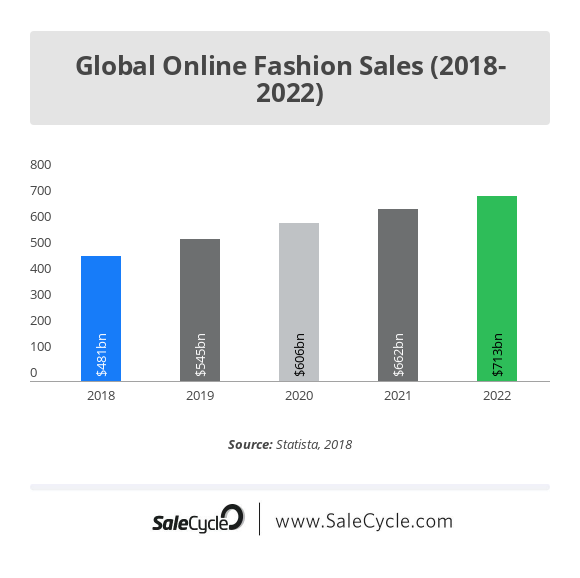
Companies operating in this industry have been keen to adjust their operations accordingly in response to the changing market forces both locally and in the international markets. According to Kingsnorth (2019), Amazon offers a wide range of products and does not primarily focus on only fashion-related products. However, it has been setting international best practices in online trade. Its many years of operating exclusively in the online retail market and the desire to improve on its product delivery have enabled it to come up with unique ways of meeting the demand of its customers. As shown in figure 2 below, this company controls about one-quarter of the global apparel industry. The company has won the trust of its customers on various fronts.
First, it has come up with a safe payment method that protects its customers from cybercriminals. They are assured of the safety of their money during and after making such payments. Amazon has also been consistent when it comes to delivering on its promise. Customers know that they will receive the exact product they purchased within the right time and without any compromise. Other dominant players in the retail industry have emulated these best practices. Walmart is the second largest company in the online sales of fashion products. This company has years of retailing experience and has been keen on digitising its sales. Kohl’s, Macy’s, JC Penney, and Nike are also major players in the industry. Others include Gap, LL Bean, and Under Armour.
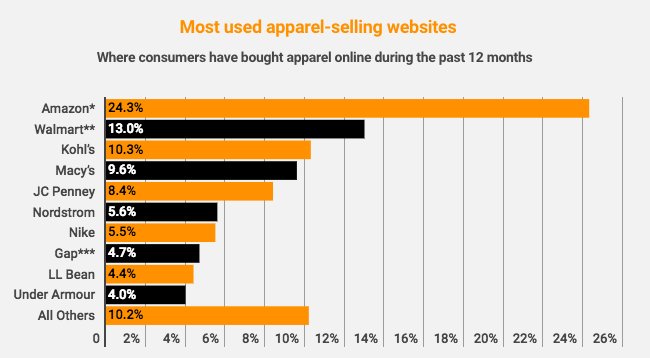
The global fashion industry is turbulent, and many companies have been forced out of the market. However, Rum (2018) notes that the demand for products offered by the industry has been growing consistently with the growing global population and increasing purchasing power. As shown in figure 3 below, total online sales in the fashion industry increased from $ 253 billion in 2014 to $ 484 billion in 2018. The growth is expected to exceed $ 765 billion, as projected in the statistics. It means that in another eight years, global online sales in fashion retail will exceed $ 1 trillion. The data below also shows a growing trend of growth in the fashion industry’s e-commerce.
In 2014, e-commerce share of the total fashion sales was estimated to be 14% of the total sales made in the industry. It increased to almost double, at 27% in 2018. The projections show that by 2022, 38% of the sales made in the fashion industry will be through online sales. Although brick-and-mortar model is still the best-preferred ways of selling fashion products, e-commerce is gaining momentum rapidly. The main reason why many people still visit these retail outlets is the desire to try out a new product and determine its suitability before making a purchase. The trend shows that soon, e-commerce will overtake the traditional bricks model of operation.
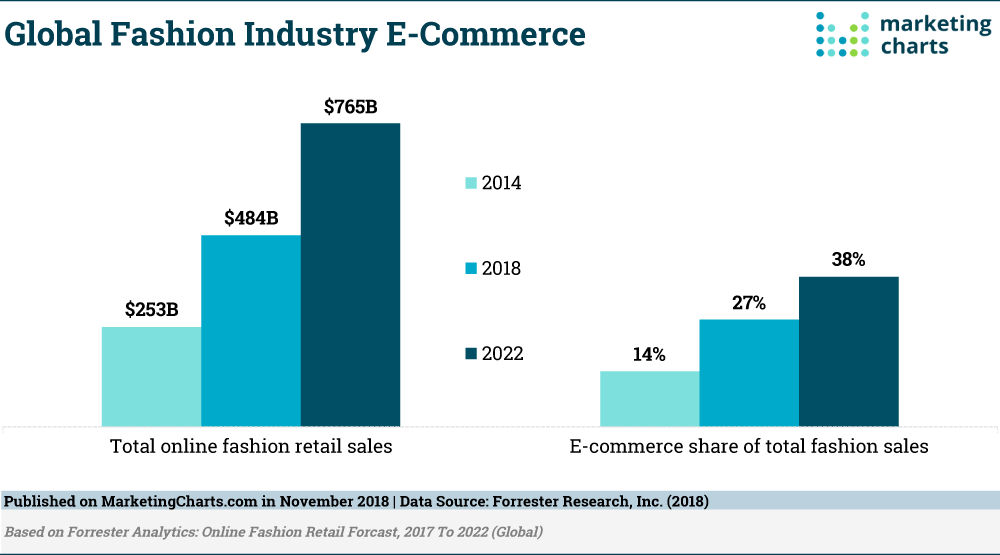
Strategic Approaches
The discussion above has shown the current trends and the growth of the global online fashion industry. In this section, the focus is to develop a digital marketing strategy for an online fashion retailer that is seeking to improve donor acquisition and retention cost effectively. In such a hyper-competitive business environment, the ability to attract and retail clients depend on the strategy that a company embraces. Bowsher (2018) argues while thousands of companies are forced out of the fashion industry every year, others are making huge profits and new entrants are achieving success despite the negative forces. It all depends on the capabilities of a firm. When developing a digital marketing strategy, the first step should be to understand specific factors that define the emerging trends and purchasing patterns of customers.
Understanding the Relationship between Fashion and Culture
One of the most important factors in the fashion industry is local cultural practices. Kingsnorth (2019) explains that although the western culture has had a significant influence on global fashion trends, one cannot ignore the impact of the local culture on this industry. What Chinese consider fashionable may not be appealing to a Briton or French. Similarly, what a South African considers trendy may not be appropriate for a Saudi Arabian. In most of the countries dominated by Muslims, women cannot wear revealing dresses popular in the west. The society has a standard dress code that women have to follow as defined by their culture. In such an environment, fashion must be based on local cultural practices. Designers have to come up with unique ways of making the dresses that are trendy for these customers while at the same time adhering to the standard practices. Peppard and Ward (2016) explain that one of the best ways of achieving a competitive advantage in such a market is integrating culture and fashion. The two cannot be looked at separately. Figure 4 below shows women embracing the haute culture fashion.

Such a dress code may not mean much to people from the United Kingdom because they do not understand the cultural ties behind it. However, people who embrace it attach specific cultural values to it and believe that it is the best way of presenting who they are to the international community. Kingsnorth (2019) believes that different communities around the world are now keen on presenting their cultural practices through their dress code. One can easily know the religious beliefs of an Islamic woman simply through their dresses. Some African communities such as the Maasai of Kenya have also retained a standard dress code that is unique to their culture. It is important to understand the local culture in a given market and the manner in which it influences fashion. The firm should then integrate fashion and the local culture to have what customers would find appealing and acceptable.
Appropriate Strategy in the Market
According to Peppard and Ward (2016), one of the initial steps that the management of a given firm has to take in its operations in the market is to define the appropriate strategic approach that it needs to embrace as a way of achieving a competitive edge over market rivals. Porter’s generic strategies identify four approaches that a firm can embrace. They include cost leadership, differentiation, differentiation focus, or cost-focus. Figure 5 below shows the model. When selecting the most appropriate strategy, important factors that have to be considered include the financial capacity of a firm, specific products it is offering in the market, the purchasing power of customers, factors that define purchasing pattern in the market, and any other issue relevant to a given industry.
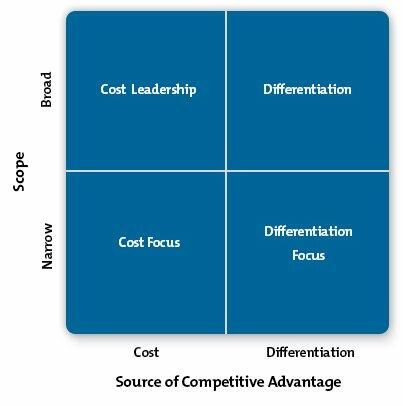
The most appropriate strategy that this firm should embrace is differentiation. According to Cordon, Garcia-Milà, Ferreiro, and Caballero (2016), people tend to associate fashionable products with a given degree of class. They would be willing to sacrifice their savings to purchase a fashionable dress or shoes. As such, when a firm uses the cost leadership strategy, people would question the quality of the product. Bowsher (2018) further explains that there is a common belief in the market that cheap products have compromised quality. In the fashion industry, such an image may have devastating consequences on the ability of a firm to achieve success. Differentiation is appropriate because it focuses on what a firm can do in a unique way compared with other rivals. In this strategy, the firm focuses on meeting customers’ needs in a way that its rivals cannot. When a firm embraces differentiation as its preferred strategy, it would need to understand its strategic position and actions that it should take to achieve a competitive edge over its rivals as shown in figure 6 below.
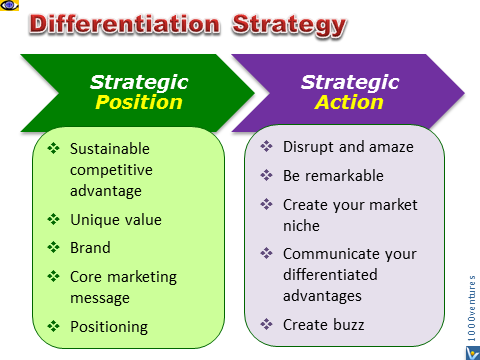
Sustainable competitive advantage is one of the important strategic positions that a firm should focus on achieving. The fashion retailer will need to find a way that it can remain competitive in its operations in a given market. Another position is having a unique value. Customers visiting the retailer should have a unique experience that would make them have the desire to revisit the facility. The brand should be known to offer the best quality at reasonable prices in the market. The core-marketing message should emphasise on the unique value that the firm offers. As discussed above, this firm should embrace the message of integrating culture and fashion as a way of achieving its goals in the market. It will remind its global clients that the primary aim of the firm is not to force fashion designs popular in the west on its global market. Instead, it seeks to provide what the locals consider appropriate based on their socio-cultural values.
When using differentiation as the appropriate strategy, Kingsnorth (2019) states that the firm would need to take specific strategic actions. Disrupting the current market practice and amazing the clients would be important. In this case, this firm will focus on doing what other firms have not considered. The action should be amazing to the customers in a way that would make them want to make another purchase. The goal is to eliminate post-purchase dissonance among customers by making the entire experience memorable. The company should be remarkable in its actions. It must meet its promise to the customers at all times and avoid unnecessary delays when handling clients’ orders. It would be necessary for the firm to communicate its differentiated advantages to its customers. The marketing message should focus on what the firm offers differently compared with its market rivals. It would also be necessary to create a buzz. Customers should feel the presence of this firm in the market not only through its promotional messages but also through also specific actions that it takes to improve the overall experience of its customers in the market.
Personalisation in the Digital Strategy
According to Camero (2018), one of the main weaknesses of the digital marketing strategy is that the physical interaction between clients and salespersons is eliminated. Customers often value that relationship, especially the feeling that employees of a firm are understanding and helpful. Personalisation in the digital strategy is an attempt to create a memorable engagement with clients despite the fact that there will be no physical interaction. One such strategy is to identify important days in customers’ lives such as birthdays or important anniversaries. When the birthday for a particular customer is approaching, the firm can make an offer of a major discount as a reward to them. A text should be sent to them a day or two to their birthday, reminding them that they are considered important customers for the firm and that it would be necessary to reward them. They would be given an opportunity to buy clothes or shoes that they can wear during this important day of their lives.
The strategy would make these customers feel valued by the firm. It creates a sense of care and a personal relationship between the company and its clients. Bowsher (2018) warns that this strategy should be used with caution. For a firm to get this information, it would mean having access to personal data of customers. The information can be available on their personal information they provide to the firm when making their purchases, or in their social network pages. Some people highly value their privacy, and when they realise that the firm is mining their details without their consent, they may be upset. As such, this firm should have its own database where its customers can indicate important dates in their lives. It will be easier for the company to use information that customers provide voluntarily instead of data mined from social media or any similar sources.
Individuals responsible for making the deliveries should be trained on how to engage customers. They are the only point of contact between customers and the firm. Robertson (2018) explains that the language that these agents use is very important. They have to be respectful and show the desire to ensure that the client is satisfied. The delivery agents should know the name of each client and preferably have a picture that would enable them to identify these customers. If they manage to make a positive identification of the customer during the delivery, they should call them by their name. Phrases such as ‘hello Mr. Gates’ or ‘good morning Miss Janet’ can help create the desired personal relationship with the customer. They will be pleased that the agent knows them by their name. When making each delivery, these agents should not behave in a way that shows they are in a hurry. They should be willing to answer any question from the customer. In case a given client wants to unwrap the product to ensure that what is delivered is the exact product they ordered, the agent should wait and ensure that the client is satisfied.
The company should create a communication platform where it can interact with its customers, address their concerns, and understand the emerging market trends. One of these ways is to create a Facebook page. In its Facebook page, this company should discuss emerging market trends and specific features that customers would want to be adjusted in the products. Clients would be invited to discuss their experienced when using products from the company and areas they would desire to see improvements made. However, Camero (2018) warns that the firm should be careful to deal with individuals who may be intent on propagating negativity and malice for personal reasons or as a way of promoting other brands. One of the common ways is to block such individuals from the Facebook page. However, that would be an indication that the firm is not willing to address such claims. As such, the best strategy would be to expose their lies by allowing genuine customers who have had good experience to defend the firm and its image. The administrator of the page should then invite the individual to present a proof of their claims so that necessary measures can be taken
The Use of Interactive Website
In this digital strategy, this firm should go beyond having a website that can enable customers to view products and make payments. Instead, the website should be an interactive platform that online clients can use to engage representatives of the firm in case they have an issue that needs clarification. A client may be interested in finding a dress of a specific material, or a special gift for someone. In a brick-and-mortar business model, these customers can easily as store representatives to help them make an appropriate choice. However, such an opportunity is often not available in this business model. An interactive website would enable a client to get clarifications and determine the best product that would meet their needs. The live chat should be simple to use and if possible, it should be available in different languages. In many developed nations such as the United Kingdom, the United States, and many others, it is common to find cases where a significant part of the population does not speak the national language. Having alternatives such as Spanish, French, Mandarin, and Arabic may help address the language barrier.
This new firm should embrace the emerging concept of 3D website designs as a strategy that would enable it to achieve a competitive edge over its rivals. The new design makes it possible for a client to have a three-dimensional view of the product they want to purchase. Instead of taking several pictures of a product at different angles, this technology makes it possible for the client visiting the website to turn the angle of the item being views to in any desired direction. Robertson (2018) explains that this new web design is gaining popularity among advertising agencies in North America, Europe, and countries in the Far East. This company should be an early adopter of the technology to ensure that it reaps the benefits it offers.
Conclusion
The fashion industry is one of those classified as hyper-competitive and firms, which are unable to cope with the emerging trends and numerous challenges, are often forced out of the market. The projection shows that this year, about 10,000 firms in this industry may be acquired by other successful firms or simply close their operations because of the inability to cope with the forces in the market. Many have closed in the previous years because of similar reasons. Despite the negativity of the statistics in this industry, the study shows that the demand for fashion products has been increasing all over the world. It means that when a firm understands how to deliver the desired value for its customers in a way that can overcome negative forces in the market, then it would be assured of growth. This new firm should understand cultural forces in the market and then develop a digital marketing strategy that meets customers’ needs. The proposed strategies of differentiation and personalisation of its online operations would be appropriate in enabling this firm to achieve success.
Recommendations
The management of this company should consider the following recommendations in its digital marketing strategy:
- A substantial amount of resources should be spent on promoting the image and brand of the firm. Customers often trust online brands, which are popular.
- Employees responsible for delivering products after purchase should be trained on how to handle different clients based on their gender, age, race, religion, or any other demographical classification.
- The firm should have an interactive website where clients can address their concerns when planning to make their purchases. The firm should also maintain an online presence through social media platforms.
- The online payment system should be secure enough to avoid any cyber-attack on the firm or its clients.
Reference List
Bowsher, E 2018, ‘Online retail sales continue to soar’, Financial Times, Web.
Camero, J 2018, Growth hacking, digital strategy & business analysis in stages workbook, Cengage Learning, New York, NY.
Cordon, C, Garcia-Milà, P, Ferreiro, V T & Caballero, P 2016, Strategy is digital: how companies can use big data in the value chain, Wiley, Hoboken, NJ.
Kingsnorth, S 2019, Digital marketing strategy: an integrated approach to online marketing, Kogan Page, London.
Peppard, J & Ward, J 2016, The strategic management of information systems: building a digital strategy, Wiley, Hoboken, NJ.
Robertson, M 2018, Digital strategy: learn to transform your business for the digital age, Cengage Learning, New York, NY.
Rum, J 2018, Post with purpose: a digital strategy handbook, Lulu Com, Morrisville, NC.